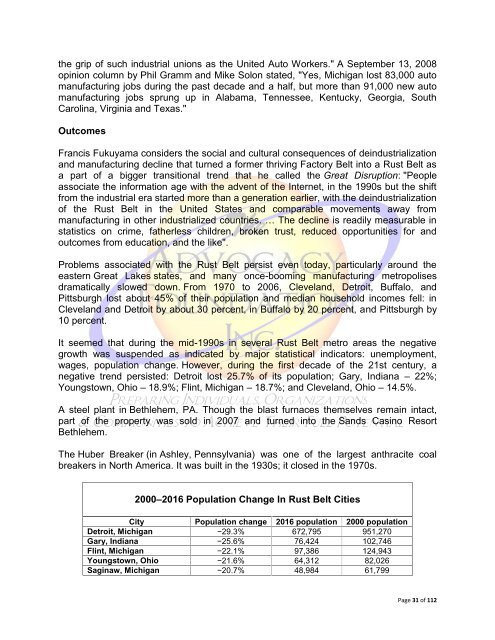De-Industrialization
De-Industrialization
De-Industrialization
You also want an ePaper? Increase the reach of your titles
YUMPU automatically turns print PDFs into web optimized ePapers that Google loves.
the grip of such industrial unions as the United Auto Workers." A September 13, 2008<br />
opinion column by Phil Gramm and Mike Solon stated, "Yes, Michigan lost 83,000 auto<br />
manufacturing jobs during the past decade and a half, but more than 91,000 new auto<br />
manufacturing jobs sprung up in Alabama, Tennessee, Kentucky, Georgia, South<br />
Carolina, Virginia and Texas."<br />
Outcomes<br />
Francis Fukuyama considers the social and cultural consequences of deindustrialization<br />
and manufacturing decline that turned a former thriving Factory Belt into a Rust Belt as<br />
a part of a bigger transitional trend that he called the Great Disruption: "People<br />
associate the information age with the advent of the Internet, in the 1990s but the shift<br />
from the industrial era started more than a generation earlier, with the deindustrialization<br />
of the Rust Belt in the United States and comparable movements away from<br />
manufacturing in other industrialized countries. … The decline is readily measurable in<br />
statistics on crime, fatherless children, broken trust, reduced opportunities for and<br />
outcomes from education, and the like".<br />
Problems associated with the Rust Belt persist even today, particularly around the<br />
eastern Great Lakes states, and many once-booming manufacturing metropolises<br />
dramatically slowed down. From 1970 to 2006, Cleveland, <strong>De</strong>troit, Buffalo, and<br />
Pittsburgh lost about 45% of their population and median household incomes fell: in<br />
Cleveland and <strong>De</strong>troit by about 30 percent, in Buffalo by 20 percent, and Pittsburgh by<br />
10 percent.<br />
It seemed that during the mid-1990s in several Rust Belt metro areas the negative<br />
growth was suspended as indicated by major statistical indicators: unemployment,<br />
wages, population change. However, during the first decade of the 21st century, a<br />
negative trend persisted: <strong>De</strong>troit lost 25.7% of its population; Gary, Indiana – 22%;<br />
Youngstown, Ohio – 18.9%; Flint, Michigan – 18.7%; and Cleveland, Ohio – 14.5%.<br />
A steel plant in Bethlehem, PA. Though the blast furnaces themselves remain intact,<br />
part of the property was sold in 2007 and turned into the Sands Casino Resort<br />
Bethlehem.<br />
The Huber Breaker (in Ashley, Pennsylvania) was one of the largest anthracite coal<br />
breakers in North America. It was built in the 1930s; it closed in the 1970s.<br />
2000–2016 Population Change In Rust Belt Cities<br />
City Population change 2016 population 2000 population<br />
<strong>De</strong>troit, Michigan −29.3% 672,795 951,270<br />
Gary, Indiana −25.6% 76,424 102,746<br />
Flint, Michigan −22.1% 97,386 124,943<br />
Youngstown, Ohio −21.6% 64,312 82,026<br />
Saginaw, Michigan −20.7% 48,984 61,799<br />
Page 31 of 112

















